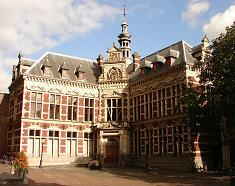Speaker
Barbara Trzeciak
(Warsaw University of Technology)
Description
Barbara Trzeciak
for the STAR Collaboration
Warsaw University of Technology / Lawrence Berkeley National Laboratory
The suppression of charmonia production in high energy nuclear collisions relative to proton-proton collisions due to the color screening was proposed as a signature of the formation of Quark-Gluon Plasma. However, there are other effects that may affect the observed charmonia production, such as cold nuclear matter effects, final state nuclear absorption, statistical coalescence of $c\bar{c}$ pairs. Studies of J/$\psi$ production and J/$\psi$ elliptic flow ($v_{2}$) in heavy-ion collisions can provide insight into the properties of the hot and dense medium created in relativistic heavy-ion collisions at RHIC. Moreover, measurements of the J/$\psi$ production for different colliding systems, centralities and collision energies may help to understand J/$\psi$ production mechanisms as well as the medium properties.
The J/$\psi$ production in $p$+$p$ collisions is equally important, as the J/$\psi$ production mechanism in elementary collisions is not yet known. Of particular interest in $p$+$p$ collisions is the J/$\psi$ cross-section and spin alignment (J/$\psi$ polarization). At high-$p_{T}$, this can provide discrimination power between different J/$\psi$ production models.
In this talk results on J/$\psi$ production via the dielectron decay channel in Au+Au, $d$+Au and $p+p$ collisions at midrapidity at $\sqrt{s_{NN}}$ = 200 GeV in STAR experiment in broad $p_{T}$ range, $0< p_T< 14~\textrm{GeV}/c$, will be presented. The J/$\psi$ nuclear modification factor in Au+Au and $d$+Au collisions as a function of centrality and $p_{T}$, and the J/$\psi$ $v_{2}$ in Au+Au collisions will be shown. The J/$\psi$ polarization measurement will be presented in $p$+$p$ collisions for J/$\psi$ $p_{T}$ from 2 to 6 GeV/$c$.
Author
Barbara Trzeciak
(Warsaw University of Technology)
